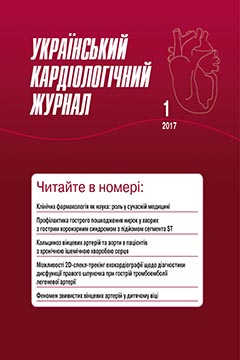Calcification of the aorta and coronary arteries in patients with chronic ischemic heart disease: age and gender characteristics, the relationship with risk factors
Main Article Content
Abstract
The aim – to evaluate relationship of coronary and aortic calcification and traditional risk factors in patients with coronary artery disease.
Materials and methods. There were 180 patients examined (69.4 % men, mean age 60.4±10.8 years). Cardiac multislice computed tomography with quantitative assessment of coronary and aortic calcification using «Smart Score» program was performed in all patients. The diagnosis of CHD was verified by сoronary catheterizationor or multislice computed tomography.
Results. Increase in coronary and aortic calcification along with age was found in both gender groups. The coronary calcium score was significantly higher (by 3 times) in men than in women of similar age. However, prevalence of calcium deposits in aorta was not significantly different in men and women.
Conclusions. Among traditional risk factors diabetes mellitus was associated with more severe coronary calcification, while hypertension was associated with aortic calcinosis. Coronary calcium score and level of calcium in aorta were significantly higher in patients with severe hypercholesterolemia (total cholesterol level ≥ 7.0 mmol/l). The relationship of other cardiovascular risk factors (smoking, peripheral atherosclerosis, family history) to coronary calcinosis was not significant.
Article Details
Keywords:
References
Жданов В.С., Веселова С.П., Дробкова И.П. и др. Некрозы и кальцификация коронарных артерий при хронической форме ишемической болезни сердца // Терапевт. архив.– 2010.– Т. 82, № 12.– С. 16–18.
Abu-El-Haija B., Ababneh B., Vacek J.L. Coronary artery calcification score and computed tomographic coronary angiography: a review and update // Open Atherosclerosis & Thrombosis J.– 2012.– Vol. 5.– P. 22–28.
Agatston A.S., Janowitz W.R., Hildner F.J. et al. Quantification of coronary artery calcium using ultrafast computed tomography // J. Am. Coll. Cardiol.– 1990.– Vol. 15 (4).– P. 827–832.
Breen J.F., Sheedy P.F., Schwartz R.S. et al. Coronary artery calcification detected with ultrafast CT as an indication of coronary artery disease // Radiology.– 1992.– Vol. 185 (2).– P. 435–439.
Budoff M.J. Atherosclerosis imaging and calcified plaque: coronary artery disease risk assessment // Prog. Cardiovasc. Dis.– 2003.– Vol. 46 (2).– P. 135–148.
Cademartiri F., La Grutta L., Palumbo A. et al. Non-invasive visualization of coronary atherosclerosis: state-of-art // J. Cardiovasc. Med. (Hagerstown).– 2007.– Vol. 8 (3).– P. 129–137.
Ghadri J.R., Fiechter M., Fuchs T.A. et al. The value of coronary calcium score in daily clinical routine, a case series of patients with extensive coronary calcifications // Int. J. Cardiol.– 2013.– Vol. 162 (2).– P. e47–49.
Gottlieb I., Miller J.M., Arbab-Zadeh A. et al. The absence of coronary calcification does not exclude obstructive coronary artery disease or the need for revascularization in patients referred for conventional coronary angiography // J. Am. Coll. Cardiol.– 2010.– Vol. 55 (7).– P. 627–634.
Hoffmann U., Massaro J.M., Fox C.S. et al. Defining normal distributions of coronary artery calcium in women and men (from the Framingham Heart Study) // Am. J. Cardiol.– 2008.– Vol. 102 (9).– P. 1136–1141.
Ibebuogu U.N., Ahmadi N., Hajsadeghi F. et al. Measures of coronary artery calcification and association with the metabolic syndrome and diabetes // J. Cardiometab. Syndr.– 2009.– Vol. 4 (1).– P. 6–11.
Margolis J.R., Chen J.T., Kong Y. et al. The diagnostic and prognostic significance of coronary artery calcification. A report of 800 cases // Radiology.– 1980.– Vol. 137 (3).– P. 609–616.
McClelland R.L., Chung К., Detrano R. et al. Distribution of coronary artery calcium by race, gender, and age: results from the Multi-Ethnic Study of Atherosclerosis (MESA) // Circulation.– 2006.– Vol. 113 (1).– Р. 30–37.
McEvoy J.W., Blaha M.J., DeFilippis A.P. et al. Coronary artery calcium progression: an important clinical measurement? // JACC.– 2010.– Vol. 56 (20).– P. 1613–1622.
Michos E.D., Nasir K., Rumberger J.A. et al. Relation of family history of premature coronary heart disease and metabolic risk factors to risk of coronary arterial calcium in asymptomatic subjects // Amer. J. Cardiol.– 2005.– Vol. 95 (5).– P. 655–657.
Newman A.B., Naydeck Sutton-Tyrrell K. et al. Coronary artery calcification in older adults to age 99: prevalence and risk factors // Circulation.– 2001.– Vol. 104 (22).– P. 2679–2684.
Pletcher M.J., Tice J.A., Pignone M. Using the coronary artery calcium score to predict coronary heart disease everts: a systematic review and meta-analysis // Arch. Intern. Med.– 2004.– Vol. 164 (12).– P. 1285–1292.
Schmermund A., Denktas A.E., Rumberger J.A. et al. Independent and incremental value of coronary artery calcium for predicting the extent of angiographic coronary artery disease: comparison with cardiac risk factors and radionuclide perfusion imaging // J. Am. Coll. Cardiol.– 1999.– Vol. 34 (3).– P. 777–786.
Williams M., Shaw L.J., Raggi P. et al. Prognostic value of number and site of calcified coronary lesions compared with the total score // JACC Cardiovasc. Imaging.– 2008.– Vol. 1 (1).– P. 61–69.
Wong N.D., Budoff M.J., Pio J. et al. Coronary calcium and cardiovascular event risk: Evaluation by age- and gender-specific quartiles // Amer. Heart J.– 2002.– Vol. 143.– P. 456–459.

